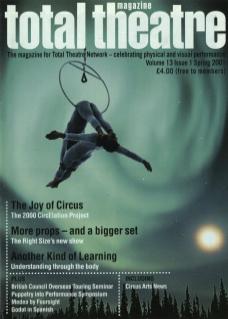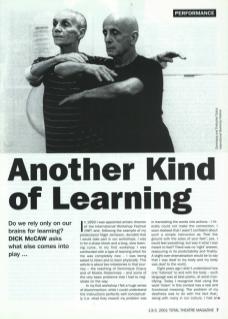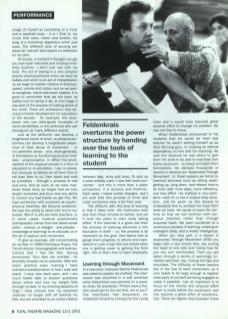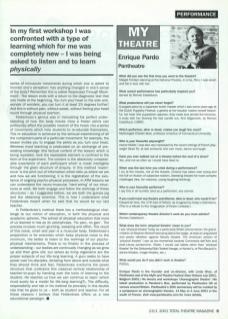In 1993 I was appointed artistic director of the International Workshop Festival (IWF) and, following the example of my predecessor Nigel Jamieson, decided that I would take part in our workshops. I was in for a sharp shock and a long, slow learning curve. In my first workshop I was confronted with a type of learning which for me was completely new – I was being asked to listen and to learn physically. This article is about two milestones in that journey – the teaching of Dominique Dupuy and of Moshe Feldenkrais – and some of the very basic problems that I had to negotiate on the way.
In my first workshop I felt a huge sense of disconnection; while I could understand the instructions perfectly well conceptually (i.e. what they meant) my problem was in translating the words into actions – I literally could not make the connection. I soon realised that I wasn't confident about such a simple instruction as 'Feel the ground with the soles of your feet': yes, I could feel something, but was it what I was meant to feel? There was no 'right' answer, reassuring in its predictability and finality. A slight over dramatisation would be to say that I was deaf to my body and my body was deaf to the world.
Eight years ago I didn't understand how one 'listened' to and with the body – such language was at best poetic, at worst mystifying. Today I recognise that using the word listen in this context has a real and functional meaning. The problem of my deafness was to do with the fact that, along with many in our culture, I had an image of myself as consisting of a mind and a separate body – it is I (that is, my mind) that sees, hears and smells; my body is a functional apparatus which just does. The different acts of sensing are taken as 'natural' and require no reflection on my part.
In my first workshop I was confronted with a type of learning which for me was completely new – I was being asked to listen and to learn physically
Of course, a moment's thought can get you over such reductive and limiting mind-body dualism. I don't just see with my eyes. The act of seeing is a very complex psycho-physical process which we learn as babies and which is an act of interpretation as we begin to master notions of distance, speed, volume and colour, and as we learn to recognise, name and recall objects. It is good to remember that we did learn as babies how to sense it all; at that stage it was part of the process of making sense of the world. There are professions that demand a further development (or education) of the senses – for example, the wine-taster who can distinguish hundreds of wines blindfolded, or the perfumer who can distinguish as many different scents.
Just as the perfumer can develop a heightened sense of smell, so physical performers can develop a heightened awareness of their sense of movement – or kinaesthetic sense – and, more generally, of themselves as functioning physical totalities – proprioception. In effect this development of the physical senses is a form of education or re-education. I say re-education because as babies we all learn how to roll over, then to sit, then stand and walk by ourselves – through a process of trial and error. And as soon as we have mastered these skills we forget that we ever taught ourselves and thus lose any ability to correct any bad habits we get into. We lose connection with ourselves as psychophysical totalities. We become scattered. We lose the ability to listen with and to our bodies. Which is why we need teachers, or in some cases, medical practitioners (orthopaedics comes from two Greek words ortho – normal, or straight – and paedos – knowledge or learning) to re-educate us in the art of posture and movement.
I'll give an example, still concentrating on my feet. In 1996 Dominique Dupuy, the French dancer, choreographer and teacher, noticed that I had flat feet. Having announced 'Your feet are horrible', he promptly showed me an exercise. After two years' practice every morning I have noticed a transformation in how I walk and stand, I have less back pain, and I am much better able to answer questions about where and how my weight falls through my feet. In my morning sessions of Yoga I have noticed how my positions (asanas) no longer drift off towards my feet, but are animated by an active relation between legs, arms and torso. To pick up a word already used, I now feel more connected – and this is more than a static connection; it is dynamic and rhythmic. Each week I notice subtle changes, and am sure that this process of inner and outer connected-ness is far from over.
The difficulty with this kind of learning is that it takes time. His instruction took less than three minutes to deliver, and yet it took two years to start really taking effect. If the exercise is a good one then the process of learning becomes a rich education in itself – i.e. the process is as important as the goal. One learns how to gauge one's progress, to attune one's sensations in such a way that one knows when one is getting close to getting the form right. You re-learn how to learn physically.
Learning through Movement
In a television interview Moshe Feldenkrais was asked to explain his method. The interviewer was slouched in a soft armchair while Feldenkrais was perched on a wooden chair. He answered, 'If there were a fire, who would get to the exit first, me or you?’ The interviewer had temporarily immobilised himself by sinking into the comfy chair and it would have required great physical effort to change his position. He was not free to move.
When Feldenkrais announced to his students that he would be their last teacher he wasn't setting himself up as their life-long guru, or creating an eternal dependency on him and his teaching. He said this because he was about to give them the skills to be able to read their own bodily structures – to teach and learn from themselves. He devised thousands of lessons to develop our ‘Awareness Through Movement'. In these lessons we return to habitual activities such as sitting down, getting up, lying down, and relearn how to do them with more ease, more efficiency, and less effort. His method is non-normative: each of us has a unique body structure, and he gives us the means to understand how to achieve the most from what we have. He hands us back the controls so that we can function with conscious intention rather than through acquired habit. We open ourselves to a continuous process of learning, creating an intelligent body, and a bodily intelligence.
When you take part in a lesson in Awareness Through Movement (ATM) you begin with a very simple test, say turning the head to one side and noting how far you can turn comfortably. Then you are taken through a series of seemingly unrelated exercises: say, moving the hips and shoulders. The difficulty of these lessons lies in the size of each movement, as it only needs to be large enough to register what parts of yourself are being engaged to make it possible. Just as important is to focus on the mental and physical effort which is made before the movement, and this requires a great effort of concentration. There are regular rests between these series of minuscule movements during which one is asked to monitor one's sensation: has anything changed in one's sense of the body? Remember this is called 'Awareness Through Movement'. The lesson ends with a return to the diagnostic test that one made at the beginning. You turn your head to the side and, wonder of wonders, you can turn it at least 25 degrees further! And this is without pain, without sweat, without forcing your head round through physical exertion.
Feldenkrais' genius was in translating his perfect understanding of how the body moves (how a frozen pelvis can profoundly affect the possible rotation of the head) into a series of movements which help students to re-educate themselves. This re-education is achieved by the sensual experiencing of all the component parts of a particular movement: for example, the lesson invites you to engage the pelvis as you turn your head. Whereas most teaching is predicated on an exchange of pre-existing knowledge (the factual content of the lesson) which is being repeated, here the repeatable element is confined to the form of the experiment. The content is the absolutely unrepeatable experience of each participant which is made intelligible through the given structure of enquiry. In this method 'experience' is the print out of information which tells us where we are and how we are functioning: it is the registration of the existence of ongoing psycho-physical processes. In ATM lessons we can understand the neuro-muscular 'hard-wiring' of our structures at work. We both engage and follow the workings of these structures – as I suggested before, we are both the guinea pig and the observing scientist. This is how I understand what Feldenkrais meant when he said that he would be our last teacher.
Feldenkrais overturns the power structure by handing over the tools of learning to the student
In Feldenkrais' method there lies a methodological challenge to our notion of education, in both the physical and academic spheres. The school of physical education that most of us learned in has as its catchphrase, 'No pain, no gain'. The process involves much grunting, sweating and effort. The result of this noise, smell and pain is a muscular body. Feldenkrais' proposition is for exercises which keep physical noise to the minimum, the better to listen to the workings of our psychophysical mechanisms. There is no finality in the process of understanding – our bodies are continually changing as we grow up and then grow old; our selves as living organisms are the proper subjects of our life-long learning. A guru seeks to have power over his disciples, dictating from above and outside what they should think and feel. Feldenkrais overturns the power structure that underpins this classical vertical relationship of teacher-to-pupil by handing over the tools of learning to the student. He teaches us how we can continue to learn (which must surely be a model for life-long learning?). The difficulty, responsibility and risk in his method lie precisely in this double role that he gives to us – both as student and teacher. For all these reasons I believe that Feldenkrais offers us a new educational paradigm.



